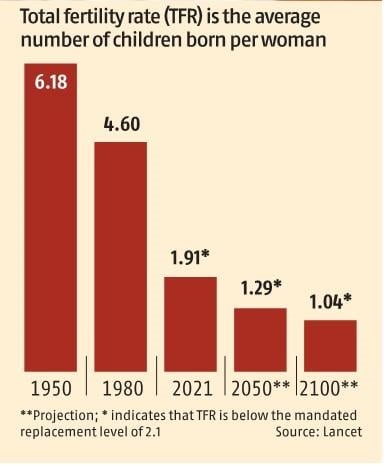Description

Disclaimer: Copyright infringement not intended.
Context
- India has experienced a significant decline in fertility rates over the past few decades. The total fertility rate (TFR) has dropped from nearly 6.2 in 1950 to just under 2 in 2021.
Details
- Projected Decline: Policymakers anticipate further declines in fertility rates to 1.29 by 2050 and a worrying level of 1.04 by 2100.
- Global Context: Falling fertility rates are not unique to India but are part of a global trend. The global fertility rate has decreased steadily, dropping nearly 50% in the past 70 years.
- UN Projections: The United Nations predicts global population growth to reach 10.9 billion by 2100, with TFR converging to near replacement level (2.1).
- Impact of Aging Population: Declining fertility rates coupled with longer life expectancies pose challenges, including provisions for social security, healthcare for the elderly, and generating employment opportunities for this demographic.
Economic Implications
- Aging Population: The aging population resulting from lower fertility rates and higher life expectancies poses economic risks, such as escalating healthcare expenses and a shrinking global workforce.
- Economic Slowdown: Factors such as wealth disparities, gender biases, and social imbalances can contribute to economic slowdowns.
Policy Response
- Demographic Dividend: India's youthful demographic, known as the demographic dividend, presents economic advantages. However, policymakers need to capitalize on this advantage to prevent India from getting stuck in the middle-income trap.
- Challenges: Policymakers face challenges in managing social security programs and healthcare infrastructure to address the needs of the growing senior citizen population.
Contributing Factors
- Health and Lifestyle: Factors like obesity, stress, smoking, and environmental pollution contribute to declining fertility rates.
- Infertility Cases: Urban areas with high-stress lifestyles and dietary patterns are witnessing a significant proportion of infertility cases, with sedentary employment increasing the risk.
- Rising Demand for IVF: The rising demand for In Vitro Fertilization (IVF) treatments underscores the growing prevalence of infertility issues, with the IVF market projected to grow substantially.

TFR as per NFHS-5
- The Total Fertility Rate (TFR) decline in India, as highlighted by the recent National Family Health Survey (NFHS-5), indicates significant demographic shifts with various implications and future considerations.
Current TFR and Sex Ratio:
- TFR Decline: India's TFR has decreased from 2.2 in 2015-16 to 2.0 at the national level, with variations observed between urban (1.6) and rural areas (2.1).
- Sex Ratio: NFHS-5 reports a sex ratio of 1,020 women per 1,000 men, a notable deviation from previous surveys.
- TFR Target: Replacement level fertility, set at 2.1, ensures each generation replaces itself. An additional 0.1 child per woman accounts for infant mortality.
Implications of TFR in India:
- Population Stability: A TFR of 2.0 indicates stable long-term population trends, with two parents replaced by two children.
- Future Growth: India may not experience population decline for 30-40 years due to a substantial youth population.
Reasons for Fertility Decline:
- Education: Higher female education levels contribute to fertility decline.
- Economic Factors: Increased mobility, late marriages, and financial independence influence family planning decisions.
- Family Planning Programs: Enhanced access to family planning methods and higher contraceptive prevalence rates play a role.
Future Considerations:
- Population Decline: Lower fertility rates may lead to population decline akin to developed countries.
- Policy Focus: Attention should shift towards improving employment opportunities, healthcare infrastructure, and social security systems to address the aging population.
- State-Level Strategies: States with higher fertility rates should prioritize improving education, income levels, and reducing infant mortality.
|
PRACTICE QUESTION
Q. The declining fertility rates in India highlight the need for proactive measures to address demographic challenges and ensure sustainable economic growth. Discuss. (250 Words)
|














